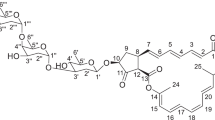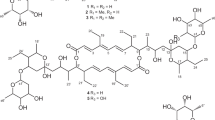Abstract
During our screening for anti-mycobacterial agents against Mycobacterium avium complex (MAC), two new polycyclic tetramate macrolactams (PTMs), named hydroxycapsimycin (1) and brokamycin (2), were isolated along with the known PTM, ikarugamycin (3), from the culture broth of marine-derived Streptomyces sp. KKMA-0239. The relative structures of 1 and 2 were elucidated by spectroscopic data analyses, including 1D and 2D NMR. Furthermore, the absolute configuration of 1 was confirmed by a single-crystal X-ray diffraction analysis. Compounds 2 and 3 exhibited moderate antimycobacterial activities against MAC, including clinically isolated drug-resistant M. avium.
This is a preview of subscription content, access via your institution
Access options
Subscribe to this journal
Receive 12 print issues and online access
$259.00 per year
only $21.58 per issue
Buy this article
- Purchase on Springer Link
- Instant access to full article PDF
Prices may be subject to local taxes which are calculated during checkout




Similar content being viewed by others
References
Adjemian J, Olivier KN, Seitz AE, Holland SM, Prevots DR. Prevalence of nontuberculous mycobacterial lung disease in U.S. Medicare beneficiaries. Am J Respir Crit Care Med. 2012;185:881–6.
Namkoong H, Kurashima A, Morimoto K, Hoshino Y, Hasegawa N, Ato M, et al. Epidemiology of pulmonary nontuberculous mycobacterial disease, Japan. Emerg Infect Dis. 2016;22:1116–7.
Fernandez-Pittol M, Batista-Arnau S, Román A, San Nicolás L, Oliver L, González-Moreno O, et al. Differences in drug-susceptibility patterns between mycobacterium avium, mycobacterium intracellulare, and mycobacterium chimaera clinical isolates: prospective 8.5-year analysis by three laboratories. Antibiotics. 2022;12:64.
Hosoda K, Koyama N, Kanamoto A, Tomoda H. Discovery of nosiheptide, griseoviridin, and etamycin as potent anti-mycobacterial agents against mycobacterium avium complex. Molecules. 2019;24:1495.
Koyama N, Shigeno S, Kanamoto A, Tomoda H. Steffimycin E, a new anti-mycobacterial agent against Mycobacterium avium complex, produced by Streptomyces sp. OPMA02852. J Antibiot. 2020;73:581–4.
Hikima A, Asamizu S, Onaka H, Zhang H, Tomoda H, Koyama N. Kimidinomycin, a new antibiotic against Mycobacterium avium complex, produced by Streptomyces sp. KKTA-0263. J Antibiot. 2022;75:72–6.
Koyama N, Kojima S, Nonaka K, Masuma R, Matsumoto M, Omura S, et al. Calpinactam, a new anti-mycobacterial agent, produced by Mortierella alpina FKI-4905. J Antibiot. 2010;63:183–6.
Methods for dilution antimicrobial susceptibility tests for bacteria that grow aerobically; approved standard—Ninth Edition, vol. 32, 9ed. Wayne, PA, USA, 2012.
Yan X, Li Y, Wang N, Chen Y, Huang LL. Streptomyces ginkgonis sp. nov., an endophyte from Ginkgo biloba. Antonie Van Leeuwenhoek. 2018;111:891–6.
Liu C, Wang X, Zhao J, Liu Q, Wang L, Guan X, et al. Streptomyces harbinensis sp. nov., an endophytic, ikarugamycin-producing actinomycete isolated from soybean root [Glycine max (L.) Merr]. Int J Syst Evol Microbiol. 2013;63:3579–84.
Yokoi K, Hasegawa H, Sato J, Matsumoto M. New antibiotic SS8201D and its manufacturing method: S. S. Pharmaceutical Co., Ltd.; 1984.
Lacret R, Oves-Costales D, Gómez C, Díaz C, de la Cruz M, Pérez-Victoria I, et al. New ikarugamycin derivatives with antifungal and antibacterial properties from Streptomyces zhaozhouensis. Mar Drugs. 2014;13:128–40.
Jomon K, Kuroda Y, Ajisaka M, Sakai H. A new antibiotic, ikarugamycin. J Antibiot. 1972;25:271–80.
Jiang M, Chen S, Li J, Liu L. The biological and chemical diversity of tetramic acid compounds from marine-derived microorganisms. Mar Drugs. 2020;18:114.
Zhang W, Zhang G, Zhang L, Liu W, Jiang X, Jin H, et al. New polycyclic tetramate macrolactams from marine-derived Streptomyces sp. SCSIO 40060. Tetrahedron. 2018;74:6839–45.
Antosch J, Schaefers F, Gulder TA. Heterologous reconstitution of ikarugamycin biosynthesis in E. coli. Angew Chem Int Ed Engl. 2014;53:3011–4.
Li Y, Chen H, Ding Y, Xie Y, Wang H, Cerny RL, et al. Iterative assembly of two separate polyketide chains by the same single-module bacterial polyketide synthase in the biosynthesis of HSAF. Angew Chem Int Ed Engl. 2014;53:7524–30.
Zhang G, Zhang W, Zhang Q, Shi T, Ma L, Zhu Y, et al. Mechanistic insights into polycycle formation by reductive cyclization in ikarugamycin biosynthesis. Angew Chem Int Ed Engl. 2014;53:4840–4.
Yu HL, Jiang SH, Bu XL, Wang JH, Weng JY, Yang XM, et al. Structural diversity of anti-pancreatic cancer capsimycins identified in mangrove-derived Streptomyces xiamenensis 318 and post-modification via a novel cytochrome P450 monooxygenase. Sci Rep. 2017;7:40689.
Blodgett JA, Oh DC, Cao S, Currie CR, Kolter R, Clardy J. Common biosynthetic origins for polycyclic tetramate macrolactams from phylogenetically diverse bacteria. Proc Natl Acad Sci USA. 2010;107:11692–7.
Fukuda T, Takahashi M, Kasai H, Nagai K, Tomoda H. Chlokamycin, a new chloride from the marine-derived streptomyces sp. MA2-12. Nat Prod Commun. 2017;12:1934578X1701200818.
Acknowledgements
We express our thanks to Ms. Noriko Sato and Ms. Reiko Seki, the School of Pharmacy, Kitasato University for instrumental measurements and Mr. Shunto Kubota, the School of Pharmacy, Kitasato University for assisting with our experiments. This work was supported by the Uehara Memorial Foundation (to HT) and a Kitasato University Research Grant for Young Researchers (to SS).
Author information
Authors and Affiliations
Corresponding authors
Ethics declarations
Conflict of interest
The authors declare no competing interests.
Additional information
Publisher’s note Springer Nature remains neutral with regard to jurisdictional claims in published maps and institutional affiliations.
Supplementary information
Rights and permissions
Springer Nature or its licensor (e.g. a society or other partner) holds exclusive rights to this article under a publishing agreement with the author(s) or other rightsholder(s); author self-archiving of the accepted manuscript version of this article is solely governed by the terms of such publishing agreement and applicable law.
About this article
Cite this article
Shigeno, S., Kadowaki, M., Nagai, K. et al. New polycyclic tetramate macrolactams with antimycobacterial activity produced by marine-derived Streptomyces sp. KKMA-0239. J Antibiot 77, 265–271 (2024). https://doi.org/10.1038/s41429-024-00710-w
Received:
Revised:
Accepted:
Published:
Issue Date:
DOI: https://doi.org/10.1038/s41429-024-00710-w



